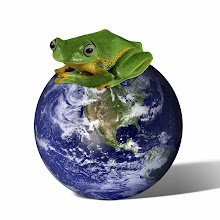Thanks to the Dutch propensity for double vowels, the first page of most dictionaries and encyclopedias includes a description of an odd little African mammal called an aardvark.
The real thing is utterly unlike the charming hero of the "Arthur" books for children. It lives its life in darkness, being absolutely nocturnal. It eats termites and little else.
Africans eat the poor thing, whose only defense are its sharp claws. It rolls onto its back and slashes at its attacker -- or digs its way to safety at amazing speed.
They also string its little peg teeth into bracelets to ward off evil. The logic of that escapes me. (Then again, people in my culture think that the severed foot of a rabbit brings them good luck.)
Millions of years ago, aardvarks ranged across Europe and Asia, apparently at a time when huge termite mounds could still be found there. Now it lives only in the dry lands from Ethiopia to South Africa, and there is only one species of it in its family.
Our world abounds in fascinating creatures -- from the stick insects of Malaysia to the lemurs of Madagascar to the grizzly bears of Alaska. I never get tired of learning about them.
The real thing is utterly unlike the charming hero of the "Arthur" books for children. It lives its life in darkness, being absolutely nocturnal. It eats termites and little else.
Africans eat the poor thing, whose only defense are its sharp claws. It rolls onto its back and slashes at its attacker -- or digs its way to safety at amazing speed.
They also string its little peg teeth into bracelets to ward off evil. The logic of that escapes me. (Then again, people in my culture think that the severed foot of a rabbit brings them good luck.)
Millions of years ago, aardvarks ranged across Europe and Asia, apparently at a time when huge termite mounds could still be found there. Now it lives only in the dry lands from Ethiopia to South Africa, and there is only one species of it in its family.
Our world abounds in fascinating creatures -- from the stick insects of Malaysia to the lemurs of Madagascar to the grizzly bears of Alaska. I never get tired of learning about them.
















7 comments:
I wonder if Aardvarks eat fire ants? We could sure use them in the Deep South, definitely in South Carolina (grin). We are as hot as Africa in the summer, our temps over 100 degrees (110-120 heat index) for weeks now, which is not unusual for July - September, even into November some freaky years.
Thanks for such an interesting post! Sending many faery xoxoxo to you today!
Thanks for stopping by my blog, I only just saw your comment there.
I am Isis so you can stop searching.
Wow, you have a really nice blog here, I am going to read through it now.
Have a great Monday.
xo
Blue
They are kind of cute.
I would totally be willing to host one as a guest animal if it got rid of fire ants, which are a plague down here......
You speak the truth, Laura! I've been to South Carolina in the summer and it's hot enough to make Satan sweat.
Gillian: I'll need to see some ID, please. lol. Welcome to the blog!
Claudia: Yep, cute little critters unless of course you are a termite.
Molly: Someone should research that. Of course, starlings and gypsy moths seemed harmless enough when they were first brought here, too.
http://en.wikipedia.org/wiki/John_Byner
Do you remember the Ant and the Aardvark cartoons ? The aardvark had a Jackie Mason voice?
Leslie: I remember those cartoons now -- boy, it's been a while, though. Cartoons were so much fun back then. I'd take the Pink Panther and Classic Loony Tunes over everything that passes for entertainment today.
Post a Comment